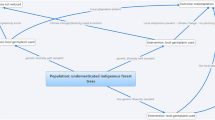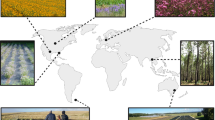Abstract
Revegetation is one practical application of science that should ideally aim to combine ecology with evolution to maximise biodiversity and ecosystem outcomes. The strict use of locally sourced seed in revegetation programs is widespread and is based on the expectation that populations are locally adapted. This practice does not fully integrate two global drivers of ecosystem change and biodiversity loss: habitat fragmentation and climate change. Here, we suggest amendments to existing strategies combined with a review of alternative seed-sourcing strategies that propose to mitigate against these drivers. We present a provenancing selection guide based on confidence surrounding climate change distribution modelling and data on population genetic and/or environmental differences between populations. Revegetation practices will benefit from greater integration of current scientific developments and establishment of more long-term experiments is key to improving the long-term success. The rapid growth in carbon and biodiversity markets creates a favourable economic climate to achieve these outcomes.


Similar content being viewed by others
References
Beaumont LJ, Pitman A, Perkins S, Zimmermann NE, Yoccoz NG, Thuiller W (2011) Impacts of climate change on the world’s most exceptional ecoregions. Proc Natl Acad Sci USA 108:2306–2311
Bellard C, Bertelsmeier C, Leadley P, Thuiller W, Courchamp F (2012) Impacts of climate change on the future of biodiversity. Ecol Lett 15:365–377
Bischoff A, Steinger T, Müller-Schärer H (2010) The importance of plant provenance and genotypic diversity of seed material used for ecological restoration. Restor Ecol 18:338–348
Breed MF, Ottewell KM, Gardner MG, Lowe AJ (2011) Clarifying climate change adaptation responses for scattered trees in modified landscapes. J Appl Ecol 48:637–641
Breed MF, Gardner MG, Ottewell K, Navarro C, Lowe A (2012) Shifts in reproductive assurance strategies and inbreeding costs associated with habitat fragmentation in Central American mahogany. Ecol Lett 15:444–452
Breed MF, Marklund MHK, Ottewell KM, Gardner MG, Harris JCB, Lowe AJ (in press) Pollen diversity matters: revealing the neglected effect of pollen diversity on fitness in fragmented landscapes. Mol Ecol. doi:10.1111/mec.12056
Broadhurst LM, Lowe A, Coates DJ, Cunningham SA, McDonald M, Vesk PA, Yates C (2008) Seed supply for broadscale restoration: maximizing evolutionary potential. Evol Appl 1:587–597
Brook BW, Sodhi NS, Bradshaw CJA (2008) Synergies among extinction drivers under global change. Trends Ecol Evol 23:453–460
Buisson L, Thuiller W, Casajus N, Lek S, Grenouillet G (2010) Uncertainty in ensemble forecasting of species distribution. Glob Change Biol 16:1145–1157
Byrne M, Stone L, Millar MA (2011) Assessing genetic risk in revegetation. J Appl Ecol 48:1365–1373
Chazdon RL (2008) Beyond deforestation: restoring forests and ecosystem services on degraded lands. Science 320:1458–1460
Cheptou P-O, Avendaño LG (2006) Pollination processes and the Allee effect in highly fragmented populations: consequences for the mating system in urban environments. New Phytol 172:774–783
Cheptou P-O, Donohue K (2010) Environment-dependent inbreeding depression: its ecological and evolutionary significance. New Phytol 189:395–407
Clarke MF, Avitabile SC, Brown L, Callister KE, Haslem A, Holland GJ, Kelly LT, Kenny SA, Nimmo DG, Spence-Bailey LM, Taylor RS, Watson SJ, Bennett AF (2010) Ageing mallee eucalypt vegetation after fire: insights for successional trajectories in semi-arid mallee ecosystems. Aust J Bot 58:363–372
Crespi BJ (2000) The evolution of maladaptation. Heredity 84:623–629
Crnokrak P, Barrett SCH (2002) Purging the genetic load: a review of the experimental evidence. Evolution 56:2347–2358
Crowe K, Parker W (2008) Using portfolio theory to guide reforestation and restoration under climate change scenarios. Clim Change 89:355–370
Davis MB, Shaw RG (2001) Range shifts and adaptive responses to Quaternary climate change. Science 292:673–679
Eckert CG, Kalisz S, Geber MA, Sargent R, Elle E, Cheptou P-O, Goodwillie C, Johnston MO, Kelly JK, Moeller DA, Porcher E, Ree RH, Vallejo-Marin M, Winn AA (2010) Plant mating systems in a changing world. Trends Ecol Evol 25:35–43
Edmands S (2007) Between a rock and a hard place: evaluating the relative risks of inbreeding and outbreeding for conservation and management. Mol Ecol 16:463–475
Forrest CN, Ottewell KM, Whelan RJ, Ayre DJ (2011) Tests for inbreeding and outbreeding depression and estimation of population differentiation in the bird-pollinated shrub Grevillea mucronulata. Ann Bot 108:185–195
Frankham R, Ballou JD, Eldridge MDB, Lacy RC, Ralls K, Dudash MR, Fenster CB (2011) Predicting the probability of outbreeding depression. Conserv Biol 25:465–475
Galatowitsch SM (2009) Carbon offsets as ecological restorations. Restor Ecol 17:563–570
Godefroid S, Piazza C, Rossi G, Buord S, Stevens A-D, Aguraiuja R, Cowell C, Weekley CW, Vogg G, Iriondo JM, Johnson I, Dixon B, Gordon D, Magnanon S, Valentin B, Bjureke K, Koopman R, Vicens M, Virevaire M, Vanderborght T (2011) How successful are plant species reintroductions? Biol Conserv 144:672–682
Gould SJ, Lewontin RC (1979) The Spandrels of San Marco and the Panglossian Paradigm: a critique of the adaptationist programme. Proc R Soc Biol Sci Ser B 205:581–598
Guerin GR, Lowe AJ (in press) Multi-species distribution modelling highlights the Adelaide Geosyncline, South Australia, as an important continental-scale arid-zone refugium. Austral Ecol. doi:10.1111/j.1442-9993.2012.02425.x
Guerin GR, Wen H, Lowe AJ (2012) Leaf morphology shift linked to climate change. Biol Lett 8:882–886
Hamilton NRS (2001) Is local provenance important in habitat creation? A reply. J Appl Ecol 38:1374–1376
Harrington MG, Gadek PA (2009) A species well travelled – the Dodonaea viscosa (Sapindaceae) complex based on phylogenetic analyses of nuclear ribosomal ITS and ETSf sequences. J Biogeogr 36:2313–2323
Hereford J (2009) A quantitative survey of local adaptation and fitness trade-offs. Am Nat 173:579–588
Hoffmann AA, Sgrò CM (2011) Climate change and evolutionary adaptation. Nature 470:479–485
Hufford KM, Mazer SJ (2003) Plant ecotypes: genetic differentiation in the age of ecological restoration. Trends Ecol Evol 18:147–155
Jennings J (2009) Natural history of the Riverland and Murraylands. Royal Society of South Australia Inc., Adelaide, SA, Australia
Johnson R, Stritch L, Olwell P, Lambert S, Horning ME, Cronn R (2010) What are the best seed sources for ecosystem restoration on BLM and USFS lands? Native Plants J 11:117–131
Kawecki TJ (2000) The evolution of genetic canalization under fluctuating selection. Evolution 54:1–12
Kawecki TJ, Ebert D (2004) Conceptual issues in local adaptation. Ecol Lett 7:1225–1241
Kramer AT, Havens K (2009) Plant conservation genetics in a changing world. Trends Plant Sci 14:599–607
Krauss SL, Koch JM (2004) Rapid genetic delineation of provenance for plant community restoration. J Appl Ecol 41:1162–1173
Leimu R, Fischer M (2008) A meta-analysis of local adaptation in plants. PLoS ONE 3:e4010
Lenormand T (2002) Gene flow and the limits to natural selection. Trends Ecol Evol 17:183–189
Lesica P, Allendorf FW (1999) Ecological genetics and the restoration of plant communities: mix or match? Restor Ecol 7:42–50
Lopez S, Rousset F, Shaw FH, Shaw RG, Ronce O (2009) Joint effects of inbreeding and local adaptation on the evolution of genetic load after fragmentation. Conserv Biol 23:1618–1627
Lowe AJ, Boshier D, Ward M, Bacles CFE, Navarro C (2005) Genetic resource impacts of habitat loss and degradation; reconciling empirical evidence and predicted theory for neotropical trees. Heredity 95:255–273
McKay JK, Christian CE, Harrison S, Rice KJ (2005) “How local is local?”—a review of practical and conceptual issues in the genetics of restoration. Restor Ecol 13:432–440
Mijnsbrugge KV, Bischoff A, Smith B (2010) A question of origin: where and how to collect seed for ecological restoration. Basic Appl Ecol 11:300–311
Montalvo AM, Williams SL, Rice KJ, Buchmann SL, Cory C, Hamdel SN, Nabhan GP, Primack R, Robichaux RH (1997) Restoration biology: a population biology perspective. Restor Ecol 5:277–290
Mortlock W (2000) Local seed for revegetation: where will all that seed come from? Ecol Manag Restor 1:93–101
Nathan R, Horvitz N, He Y, Kuparinen A, Schurr FM, Katul GG (2011) Spread of North American wind-dispersed trees in future environments. Ecol Lett 14:211–219
Noël F, Prati D, van Kleunen M, Gygax A, Moser D, Fischer M (2011) Establishment success of 25 rare wetland species introduced into restored habitats is best predicted by ecological distance to source habitats. Biol Conserv 144:602–609
North A, Pennanen J, Ovaskainen O, Laine A-L (2011) Local adaptation in a changing world: the roles of gene-flow, mutation, and sexual reproduction. Evolution 65:79–89
O’Brien EK, Krauss SL (2010) Testing the home-site advantage in forest trees on disturbed and undisturbed sites. Restor Ecol 18:359–372
O’Brien EK, Mazanec RA, Krauss SL (2007) Provenance variation of ecologically important traits of forest trees: implications for restoration. J Appl Ecol 44:583–593
O’Neill GA, Nigh G (2011) Linking population genetics and tree height growth models to predict impacts of climate change on forest production. Glob Change Biol 17:3208–3217
Parmesan C (2006) Ecological and evolutionary responses to recent climate change. Annu Rev Ecol Evol Syst 37:637–669
Petit RJ, Hampe A (2006) Some evolutionary consequences of being a tree. Annu Rev Ecol Evol Syst 37:187–214
Prentis PJ, Wilson JRU, Dormontt EE, Richardson DM, Lowe AJ (2008) Adaptive evolution in invasive species. Trends Plant Sci 13:288–294
SER (2004) The SER international primer on ecological restoration, Version 2. Society for Ecological Restoration Science and Policy Working Group, Tucson, Arizona
Sgrò CM, Lowe AJ, Hoffmann AA (2011) Building evolutionary resilience for conserving biodiversity under climate change. Evol Appl 4:326–337
Slee A, Brooker M, Duffy S, West J (2006) EUCLID: eucalyptus of Australia, 3rd edn. Centre for Plant Biodiversity Research, Canberra
Thomas CD (2011) Translocation of species, climate change, and the end of trying to recreate past ecological communities. Trends Ecol Evol 26:216–221
Vesk PA, Mac Nally R (2006) The clock is ticking—revegetation and habitat for birds and arboreal mammals in rural landscapes of southern Australia. Agric Ecosyst Environ 112:356–366
Vranckx GUY, Jacquemyn H, Muys B, Honnay O (2011) Meta-analysis of susceptibility of woody plants to loss of genetic diversity through habitat fragmentation. Conserv Biol 26:228–237
Wang T, O’Neill GA, Aitken SN (2010) Integrating environmental and genetic effects to predict responses of tree populations to climate. Ecol Appl 20:153–163
Weeks AR, Sgro CM, Young AG, Frankham R, Mitchell NJ, Miller KA, Byrne M, Coates DJ, Eldridge MDB, Sunnucks P, Breed MF, James EA, Hoffmann AA (2011) Assessing the benefits and risks of translocations in changing environments: a genetic perspective. Evol Appl 4:709–725
Weinreich DM, Watson RA, Chao L, Harrison R (2009) Sign epistasis and genetic constraint on evolutionary trajectories. Evolution 59:1165–1174
Wiens JA, Stralberg D, Jongsomjit D, Howell CA, Snyder MA (2009) Niches, models, and climate change: assessing the assumptions and uncertainties. Proc Natl Acad Sci USA 106:19729–19736
Wilkinson DM (2001) Is local provenance important in habitat creation? J Appl Ecol 38:1371–1373
Willi Y, Van Buskirk J, Hoffmann AA (2006) Limits to the adaptive potential of small populations. Annu Rev Ecol Evol Syst 37:433–458
Wuethrich B (2007) Biodiversity: reconstructing Brazil’s Atlantic rainforest. Science 315:1070–1072
Zerger A, Freudenberger D, Thackway R, Wall D, Cawsey M (2009) VegTrack: a structured vegetation restoration activity database. Ecol Manag Restor 10:136–144
Zhu K, Woodall CW, Clark JS (2011) Failure to migrate: lack of tree range expansion in response to climate change. Glob Change Biol 18:1042–1052
Acknowledgments
This work was supported by Australian Research Council Linkage project (LP110200805) and South Australian Premier’s Science and Research Fund awarded to AJL, NCCARF Travel Grants awarded to MFB, and the Native Vegetation Council of South Australia (grant 09/10/27), Nature Foundation SA Inc., Australian Geographic Society, Biological Society of South Australia, Field Naturalist Society of South Australia, Wildlife Preservation Society of Australia awarded to MFB, MGG, KMO and AJL. The authors would like to thank the Editors and two anonymous reviewers whose suggestions greatly improved this manuscript.
Author information
Authors and Affiliations
Corresponding author
Rights and permissions
About this article
Cite this article
Breed, M.F., Stead, M.G., Ottewell, K.M. et al. Which provenance and where? Seed sourcing strategies for revegetation in a changing environment. Conserv Genet 14, 1–10 (2013). https://doi.org/10.1007/s10592-012-0425-z
Received:
Accepted:
Published:
Issue Date:
DOI: https://doi.org/10.1007/s10592-012-0425-z




